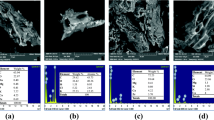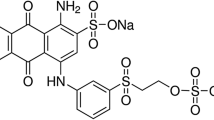Abstract
In this study, biochar derived from agricultural bio-wastes of rice husk was used as a biosorbent for dye sequestration of Basic Blue 41 (BB41) and Basic Red 09 (BR09) from the aqueous solution. The structural characteristics of the biochar were performed through TGA, BET, SEM, EDX, and FTIR. The experimental conditions proved that 80% of dye removal was attained in the optimal operating conditions (dosage of 6 g L−1 (BB41), 1 g L−1 (BR09), pH of 7 (BB41) and 8 (BR09), temperature of 35 °C, and initial dye concentration of 50 mg L−1). Four different isotherms models were used to describe the adsorption process. Based on the correlation coefficient and percentage of error values, BB41 and BR09 sorption revealed that Langmuir model has better fit when compared to other models. The maximum adsorption capacities of BB41 and BR09 on rice husk biochar are 17.596 mg g−1 and 168.49 mg g−1, respectively. The thermodynamic parameters △H < 0 and △G < 0 indicated that the whole adsorption process of rice husk biochar to BB41 and BR09 is exothermic and spontaneous at low temperature. The regeneration studies were carried out with different elutants to confirm the elution efficiency of the sorbent. The results indicate the biochar derived from agricultural bio-waste of rice husk was a potentially greening biosorbent for the dye sequestration from wastewater.
Graphical abstract



















Similar content being viewed by others
References
Saleh TA, Gupta VK (2014) Processing methods, characteristics and adsorption behavior of tire derived carbons: a review. Adv Colloid Interf Sci 211:93–101. https://doi.org/10.1016/J.CIS.2014.06.006.
Thillainayagam BP, Saravanan P, Ravindiran G et al. (2021) Continuous sorption of methylene blue dye from aqueous solution using effective microorganisms-based water hyacinth waste compost in a packed column. Biomass Conv Bioref. https://doi.org/10.1007/s13399-020-01208-9
Edokpayi JN, Odiyo JO, Durowoju OS (2017). Impact of wastewater on surface water quality in developing countries: a case study of South Africa, Water Quality, Hlanganani Tutu, IntechOpen, https://doi.org/10.5772/66561
Nethaji S, Sivasamy A, Thennarasu G, Saravanan S (2010) Adsorption of malachite green dye onto activated carbon derived from Borassus aethiopum flower biomass. J Hazard Mater 181:271–280. https://doi.org/10.1016/j.jhazmat.2010.05.008
Kant R (2012) Textile dyeing industry an environmental hazard. Nat Sci 4:22–26. https://doi.org/10.4236/ns.2012.41004.
Jegan J, Praveen S, Bhagavathi Pushpa T, Gokulan R (2020a) Biodecolorization of basic violet 03 using biochar derived from agricultural wastes: isotherm and kinetics. Journal of Biobased Materials and Bioenergy 14(03):316–326. https://doi.org/10.1166/jbmb.2020.1969
Jegan J, Praveen S, Bhagavathi Pushpa T, Gokulan R (2020b) Sorption kinetics and isotherm studies of cationic dyes using groundnut (Arachis hypogaea) shell derived biochar a low-cost adsorbent. Appl Ecol Environ Res 18(1):1925–1939. https://doi.org/10.15666/aeer/1801_19251939
Zolliger H Color chemistry-syntheses, properties, and applications of organic dyes and pigments, (3rd ed.), Verlag Helvetica Chimica Acta, Wiley-VCH (2003) p. 202–206
Hubbe MA, Beck KR, O’Neal WG, Sharma YC (2012) Cellulosic substrates for removal of pollutants from aqueous systems: a review. 2. Dyes. Dye biosorption: review. Bio Resources 7(2):2592–2687
Siddique K, Rizwan M, Shahid MJ, Ali S, Ahmad R, Rizvi H (2017) Textile wastewater treatment options: a critical review. In: Anjum N., Gill S., Tuteja N. (eds) Enhancing Cleanup of Environmental Pollutants. vol. 2, pp 183–207. 10.1007/978-3-319-55423-5_6
Gokulan R, Raja Murugadoss J, Jegan J, Avinash A (2019) Comparative desorption studies on remediation of remazol dyes using biochar (sorbent) derived from green marine seaweeds. ChemistrySelect. 4:7437–7445
Ahmad T, Danish M, Rafatullah M, Ghazali A, Sulaiman O, Hashim R, Ibrahim MN (2012) The use of date palm as a potential adsorbent for wastewater treatment: a review. Environ Sci Technol 19:1464–1484
Gupta VK, Nayak A (2012) Cadmium removal and recovery from aqueous solutions by novel adsorbents prepared from orange peel and Fe2O3 nanoparticles. Chem Eng J 180:81–90
Gupta VK, Jain R, Nayak A, Agarwal S, Shrivastava M (2011) Removal of the hazardous dye-tartrazine by photodegradation on titanium dioxide surface. J Hazard Mater 31:1062–1067
Low LW, Teng T, Rafatullah M, Morad N, Azahari B (2014) Adsorption studies of methylene blue and malachite green from aqueous solutions by pretreated lignocellulosic materials. Separ Sci Technol 48:1688–1698
Mittal A, Mittal J, Malviya A, Kaur D, Gupta VK (2010) Decoloration treatment of a hazardous triarylmethane dye, light green SF (yellowish) by waste material adsorbents. J Colloid Interface Sci 342:518–527
Gupta VK, Ali I, Saleh TA, Nayak A, Agarwal S (2012a) Chemical treatment technologies for waste-water recycling-an overview. RSC Adv 2:6380–6388
Gupta VK, Jain R, Mittal A, Tawfik A, Saleh A, Naya A, Agarwal S, Sikarwa S (2012b) Photo-catalytic degradation of toxic dye amaranth on TiO2/UV in aqueous suspensions. Mater Sci Eng C 32:12–17
Saleh TA, Gupta VK (2012) Photo-catalyzed degradation of hazardous dye methyl orange by use of a composite catalyst consisting of multi-walled carbon nanotubes and titanium dioxide. J Colloid Interface Sci 371:101–106
Bhagavathi Pushpa T, Jegan J, Praveen S (2016) Utilization of biomass in environs–a review. International Journal of Advances in Interdisciplinary Research 3(7):21–26
Ahmaruzzaman M, Gupta VK (2011) Rice husk and its ash as low-cost adsorbents in water and wastewater treatment. Ind Eng Chem Res 50:13589–13613. https://doi.org/10.1021/ie201477c.
Bharathi KS, Ramesh ST (2013) Removal of dyes using agricultural waste as low-cost adsorbents: a review. Appl Water Sci 3:773–790. https://doi.org/10.1007/s13201-013-0117-y
Gupta VK, Nayak A, Bhushan B, Agarwal S (2015) A critical analysis on the efficiency of activated carbons from low-cost precursors for heavy metals remediation. Crit Rev Environ Sci Technol 45:613–668
Praveen S, Bhagavathi Pushpa T, Gokulan R & Jegan J 2020 “Evaluation of the adsorption capacity of Cocos nucifera shell derived biochar for basic dyes sequestration from aqueous solution” Energy Sources, Part A: Recovery, Utilization, and Environmental Effects, https://doi.org/10.1080/15567036.2020.1800142
Sharma P, Kaur H, Sharma M, Sahore V (2011) A review on applicability of naturally available adsorbents for the removal of hazardous dyes from aqueous waste. Environ Monit Assess 183(1–4):151–195. https://doi.org/10.1007/s10661-011-1914-0
Abdolali A, Guo WS, Ngo HH, Chen SS, Nguyen NC, Tung KL (2014) Typical lignocellulosic wastes and by-products for biosorption process in water and wastewater treatment: a critical review. Bioresour Technol 160:57–66. https://doi.org/10.1016/j.biortech.2013.12.037
Nguyen TAH, Ngo HH, Guo WS, Zhang J, Liang S, Yue QY, Li Q, Nguyen TV (2013) Applicability of agricultural waste and by-products for adsorptive removal of heavy metals from wastewater. Bioresour Technol 148:574–585. https://doi.org/10.1016/J.BIORTECH.2013.08.124
Allen B, Nanni S, Schweitzer J-P, Baldock D, Watkins E, Withana S, Bowyer C (2015) International review of bio-economy strategies with a focus on waste resources. Report prepared for the UK Government Department for Business, Innovation and Skills. Institute for European Environmental Policy, London
Lal R (2005) World crop residues production and implications of its use as a biofuel. Environ Int 31:575e584
Yagmur E, Ozmak M, Aktas Z (2008) A novel method for production of activated carbon from waste tea by chemical activation with microwave energy. Fuel 87:3278–3285
Lehmann J, Joseph S (2009) Biochar for environmental management: an introduction. In: Lehmann J, Joseph S (eds) Biochar for environmental management science and technology. Earthscan Ltd., London, UK, pp 1–12
Kumar M, Gokulan R, Sujatha S et al. (2021) Biodecolorization of Reactive Red 120 in batch and packed bed column using biochar derived from Ulva reticulata. Biomass Conv Bioref. https://doi.org/10.1007/s13399-020-01268-x
Mohan D, Sarswat A, Ok YS, Pittman CU Jr (2014) Organic and inorganic contaminants removal from water with biochar, a renewable, low cost and sustainable adsorbent - a critical review. Bioresour Technol 160:191–202
Ahmad M, Rajapaksha AU, Lim JE, Zhang M, Bolan N, Mohan D, Vithanage M, Lee SS, Ok YS (2014) Biochar as a sorbent for contaminant management in soil and water: a review. Chemosphere 99:19–33
Luo Z, Wang E, Zheng H, Baldock JA, Sun OJ, Shao Q (2015) Convergent modelling of past soil organic carbon stocks but divergent projections. Biogeosciences 12:4373–4383
Jegan J, Vijayaraghavan J, Bhagavathi Pushpa T, Sardhar Basha SJ (2016) Application of seaweeds for the removal of cationic dye from aqueous solution. Desalin Water Treat 57(53):25812–25821. https://doi.org/10.1080/19443994.2016.1151835
Zainab Mahdi, El Hanandeh A, Yu1 Q (2017). Date seed-derived biochar for Ni(II) removal from aqueous solutions, MATEC Web of Conferences 120, 05005
Sun J, He F, Pan Y, Zhang Z (2017) Effects of pyrolysis temperature and residence time on physicochemical properties of different biochar types. Acta Agric Scand Sect B Soil Plant Sci 67:12–22
Demirbas A (2008) Bio-fuels from agricultural residues. Energy Sources, Part A: Recovery, Utilization, and Environmental Effects 30:101–109. https://doi.org/10.1080/00908310600626788
Mimmo T, Panzacchi P, Baratieri M, Davies CA, Tonon G (2014) Effect of pyrolysis temperature on miscanthus (Miscanthus x giganteus) biochar physical, chemical and functional properties. Biomass Bioenergy 62:149–157
Xu Y, Chen B (2013) Investigation of thermodynamic parametres in the pyrolysis conversion f biomass and manure to biochars using thermogravimetrisc analysis. Bioresource Tenhnol 146:485–493
Krishnamurthy TP, Gowrishankar BS, Chandra Prabha MN, Kruthi M, Hari Krishna R (2019) Studies on batch adsorptive removal of malachite green from synthetic wastewater using acid treated coffee husk: equilibrium, kinetics and thermodynamic studies. Microchem J. https://doi.org/10.1016/j.microc.2018.12.067
Biagini E, Narducci P, Tognotti L (2008) Size and structural characterization of lignin-cellulosic fuels after the rapid devolatilization. Fuel 87(2):177–186. https://doi.org/10.1016/j.fuel.2007.04.010
Suman S, Panwar DS, Gautam S (2017) Surface morphology properties of biochars obtained from different biomass waste. Energy Sources, Part A: Recovery, Utilization, and Environmental Effects 39(10):1007–1012. https://doi.org/10.1080/15567036.2017.1283553.
Masoudi Soltani S, Yazdi SK, Hosseini S (2013) Effects of pyrolysis conditions on the porous structure construction of mesoporous charred carbon from used cigarette filters. Appl Nanosci 4(5):551–569. https://doi.org/10.1007/s13204-013-0230-0
Bhagavathi Pushpa T, Jegan J, Praveen S, Gokulan R (2019) Biodecolorization of basic blue 41 using EM based composts: isotherm and kinetics. Chemistry Select 4(34):10006–10012. https://doi.org/10.1002/slct.201901774
Oh TK, Choi B, Shinogi Y, Chikushi J (2012) Characterization of biochar derived from three types of biomass. J Fac Agric Kyushu Univ 57(1):61–66
Shirmardi M, Alavi N, Lima EC, Takdastan A, Mahvi AH, Babaei AA (2016) Removal of atrazine as an organic micro-pollutant from aqueous solutions: a comparative study. Process Saf Environ Prot 103:23–35. https://doi.org/10.1016/j.psep.2016.06.014
Tsai W-T, Chen H-R (2013) Adsorption kinetics of herbicide paraquat in aqueous solution onto a low-cost adsorbent, swine-manure-derived biochar. Int J Environ Sci Technol 10(6):1349–1356. https://doi.org/10.1007/s13762-012-0174-z
Fahmi AH, Samsuri AW, Jol H, Singh D (2018) Bioavailability and leaching of cd and Pb from contaminated soil amended with different sizes of biochar. R Soc Open Sci 5(11):181328. https://doi.org/10.1098/rsos.181328
Wang Z, Shen D, Shen F, Li T (2016) Phosphate adsorption on lanthanum loaded biochar. Chemosphere 150:1–7
Kyzioł-Komosińska J, Rosik-Dulewska C, Pajak M, et al. (2014) Adsorption of anionic dyes onto natural, thermally and chemically modified smectite clays. Polish J Chem Technol. https://doi.org/10.2478/pjct-2014-0066
Tabak A, Eren E, Afsin B, Caglar B (2009) Determination of adsorptive properties of a Turkish Sepiolite for removal of Reactive Blue 15 anionic dye from aqueous solutions. J Hazard Mater. https://doi.org/10.1016/j.jhazmat.2008.04.062
Author information
Authors and Affiliations
Corresponding author
Ethics declarations
Conflict of interest
The authors declare no conflict of interest.
Additional information
Publisher’s note
Springer Nature remains neutral with regard to jurisdictional claims in published maps and institutional affiliations.
Rights and permissions
About this article
Cite this article
Saravanan, P., Josephraj, J., Thillainayagam, B.P. et al. Evaluation of the adsorptive removal of cationic dyes by greening biochar derived from agricultural bio-waste of rice husk. Biomass Conv. Bioref. 13, 4047–4060 (2023). https://doi.org/10.1007/s13399-021-01415-y
Received:
Revised:
Accepted:
Published:
Issue Date:
DOI: https://doi.org/10.1007/s13399-021-01415-y




